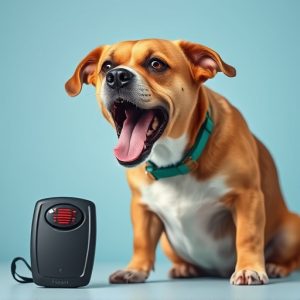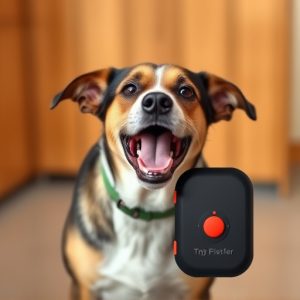Sonic Dog Training: Effective Correction with Handheld Devices & Optimal Carrying Techniques
Sonic dog training employs handheld devices that emit specific audio frequencies to modify canine be…….
Sonic dog training employs handheld devices that emit specific audio frequencies to modify canine behavior non-invasively, using safe alternatives to traditional methods. These portable tools can be held or attached to collars, offering effective behavior management during sessions. Handheld Dog Deterrent Devices, also known as electronic training aids, come in various types and designs with adjustable electric shocks delivered through collars to discourage unwanted behaviors. Proper carrying methods, like firm grips, harnesses, or pouches, enhance training effectiveness and comfort. Safety is paramount when using these devices, following manufacturer guidelines, keeping them out of reach of children and other pets, and using them as a last resort after exhausting positive reinforcement techniques.
“Explore the innovative world of sonic dog training, a behavioral correction method gaining traction among pet owners. This article delves into the science behind sound waves as a training tool and their impact on canine behavior. We’ll guide you through various handheld dog deterrent devices, discussing different types and their unique functionalities. Additionally, discover optimal carrying methods to enhance training effectiveness while prioritizing safety. By understanding these key aspects, you’ll be well-equipped to navigate sonic dog training with success.”
- Understanding Sonic Dog Training and Behavioral Correction
- Handheld Dog Deterrent Devices: Types and Functionality
- Effective Carrying Methods for Optimal Training Results
- Safety Considerations and Best Practices for Sonic Dog Training
Understanding Sonic Dog Training and Behavioral Correction
Sonic dog training and behavioral correction involve using specific audio frequencies to modify a canine’s behavior. This modern approach differs from traditional methods by offering a non-invasive, safe alternative for addressing unwanted actions. It utilizes handheld devices that emit sounds at precise frequencies designed to disrupt or redirect a dog’s attention, promoting positive reinforcement.
These devices are easily portable, with various carrying methods suitable for different situations. Users can carry them in hands, attach them to collars, or store them in pockets during training sessions. The versatility of handheld dog deterrent methods allows for discrete and effective management of a dog’s behavior, making it a popular choice among responsible pet owners and professional trainers alike.
Handheld Dog Deterrent Devices: Types and Functionality
Handheld Dog Deterrent Devices, also known as electronic training aids or remote trainers, are a popular choice for pet owners looking to correct behavioral issues in their dogs. These devices come in various types and designs, each with unique features catering to different training needs. The most common handheld deterrents utilize mild electric shocks delivered through a collar to discourage unwanted behaviors. These shocks are adjustable and designed to be safe and humane, only serving as a brief distraction or reminder to the dog.
In terms of carrying methods, these devices often come with ergonomic designs and durable cases for easy transportation. Some models even offer rechargeable batteries and customizable settings, allowing owners to adapt the training experience according to their dog’s needs. This flexibility makes them convenient tools for outdoor walks, training sessions at parks, or addressing specific behavioral challenges in various environments.
Effective Carrying Methods for Optimal Training Results
When it comes to sonic dog training and behavioral correction, the way you carry your handheld deterrent device can significantly impact the effectiveness of the training. For optimal results, consider using handheld dog deterrent carrying methods that ensure both control and comfort for both you and your canine companion. One effective method is the firm but gentle grip: hold the device with a secure yet relaxed grasp, allowing quick access while maintaining a steady hand to prevent accidental triggers.
Another practical approach involves utilizing a customized harness or pouch. A specialized harness designed for deterrent devices can distribute weight evenly and keep the device close to your body, minimizing the risk of it bouncing or swinging and accidentally startling your dog. Alternatively, a secure pouch attached to your belt or waist allows easy retrieval while keeping the device hidden from the dog’s view, preventing unnecessary distractions during training sessions.
Safety Considerations and Best Practices for Sonic Dog Training
When it comes to sonic dog training and behavioral correction, safety is paramount. Using handheld dog deterrents, such as ultrasonic devices or spray-based options, requires careful consideration to ensure both the well-being of your pet and your own safety during training sessions. Always follow manufacturer guidelines regarding usage frequency and range to avoid any potential harm from excessive exposure to sound or chemicals. Moreover, keep these devices out of reach of children and other pets in the household to prevent accidental activation or misuse.
Best practices for sonic dog training involve targeting specific behaviors with consistent triggers. Use these tools as a last resort when positive reinforcement techniques have been exhausted. Timing is crucial; activate the device precisely when the unwanted behavior occurs. Regular, short training sessions are more effective than long, intense ones. Additionally, maintain clear communication with your dog using a calm, assertive tone to reinforce desired behaviors. Always store handheld deterrents securely and dispose of any used products responsibly to ensure safety for everyone involved.
Sonic dog training, leveraging handheld deterrent devices, offers a modern approach to behavioral correction. By understanding different device types and optimal carrying methods, trainers can enhance effectiveness while prioritizing safety. Adhering to best practices ensures positive results without causing harm. Incorporating these techniques into your routine can help transform canine behavior in a humane and efficient manner.


